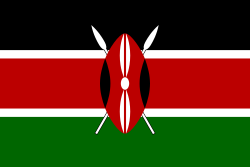Portal:Kenya

Introduction  Kenya, officially the Republic of Kenya, is a country located in East Africa. With an estimated population of more than 52.4 million as of mid-2024, Kenya is the 27th-most-populous country in the world and the 7th most populous in Africa. Kenya's capital and largest city is Nairobi. The second-largest and oldest city is Mombasa, a major port city located on Mombasa Island. Other major cities within the country include Kisumu, Nakuru and Eldoret. Going clockwise Kenya is bordered by South Sudan to the northwest (though much of that border includes the disputed Ilemi Triangle), Ethiopia to the north, Somalia to the east, the Indian Ocean to the southeast, Tanzania to the southwest, and Lake Victoria and Uganda to the west. Kenya's geography, climate and population vary widely. In western rift valley counties, the landscape includes cold, snow-capped mountaintops (such as Batian, Nelion, and Point Lenana on Mount Kenya) with vast surrounding forests, wildlife, and fertile agricultural regions in temperate climates. In other areas, there are dry, arid, and semi-arid climates, as well as absolute deserts (such as Chalbi Desert and Nyiri Desert). Kenya's earliest inhabitants included some of the first humans to evolve from ancestral members of the genus Homo. Ample fossil evidence for this evolutionary history has been found at Koobi Fora. Later, Kenya was inhabited by hunter-gatherers similar to the present-day Hadza people. According to archaeological dating of associated artifacts and skeletal material, Cushitic speakers first settled in the region's lowlands between 3,200 and 1,300 BC, a phase known as the Lowland Savanna Pastoral Neolithic. Nilotic-speaking pastoralists (ancestral to Kenya's Nilotic speakers) began migrating from present-day South Sudan into Kenya around 500 BC. Bantu people settled at the coast and the interior between 250 BC and 500 AD. European contact began in 1500 AD with the Portuguese Empire, and effective colonisation of Kenya began in the 19th century during the European exploration of Africa. Modern-day Kenya emerged from a protectorate, established by the British Empire in 1895 and the subsequent Kenya Colony, which began in 1920. Mombasa was the capital of the British East Africa Protectorate, which included most of what is now Kenya and southwestern Somalia, from 1889 to 1907. Numerous disputes between the UK and the colony led to the Mau Mau revolution, which began in 1952, and the declaration of Kenya's independence in 1963. After independence, Kenya remained a member of the Commonwealth of Nations. The country's current constitution was adopted in 2010, replacing the previous 1963 constitution. (Full article...)
Selected article - Del Monte Kenya Limited is a Kenyan food processing company that operates in the cultivation, production, and canning of pineapple products. The company produces canned solid pineapple, juice concentrates, mill juice sugar and cattle feed. Kenya's largest single manufactured export is canned pineapple, and the country ranks among the top five pineapple exporters in the world, both of which feats are direct results of the company's existence and operations. In the past, the company received negative publicity stemming from conflicts with workers and human rights groups, and the company has been targeted by human rights groups for hazardous conditions at the facility, poor living and working conditions for workers and for intimidating trade union groups. In 2001, the company took significant steps to address and correct matters per these concerns. (Full article...) Selected picture - Birds on the harbour of Lake Victoria, Kenya.
Selected location - Samburu County is the 10th largest county by size in Kenya. Its population as of 2009 is 223,947. (Read more...) This is a Good article, an article that meets a core set of high editorial standards.
Msambweni (meaning "land of Msambwe") in Swahili) is a small fishing town and constituency in Kwale County of southeastern Kenya, formerly in Kwale District of Coast Province. The origin of the name, Msambwe (plural Misambwe) refers to a hardy and wild fruits (sambwe) tree indigenous to the area. A few remnants of the Msambwe trees are still existing at Mkunguni Beach, Sawa Sawa Village. By road, Msambweni is 55.4 kilometres (34.4 mi) south of Mombasa and 46.5 kilometres (28.9 mi) northeast of Lunga Lunga on the Tanzanian border. As of 2009, the town had a population of 11,985 people. Fishing is the primary source of income, although coconut palm, buxa coloring, cashew nuts and fruits are produced for trade. Because of its reef and extensive beaches, the snorkeling industry is gaining in popularity in Msambweni, and holiday cottages and hotels have sprung up in the area, such as the Msambweni Beach House. The town is noted for its leprosarium and contains the Msambweni District Hospital. The Koromojo Dam is immediately north of the town. (Full article...) Selected biography -Fitzval Remedios Santana Neville de Souza (1929 – 23 March 2020), better known as F.R.S. de Souza or Fitz de Souza, was a Kenyan lawyer and politician who was an important figure in the campaign for independence for Kenya, a member of the Kenyan parliament in the 1960s and Deputy Speaker for several years. He helped provide a legal defence for those accused of Mau Mau activities including the Kapenguria Six, and he was one of the people involved in the Lancaster House conferences held to draw up a constitutional framework for Kenyan independence. (Full article...) Related portalsDid you know (auto-generated) -
In the news
Wikinews Kenya portal
Selected panorama -General images -The following are images from various Kenya-related articles on Wikipedia.
Topics in KenyaCategoriesAssociated WikimediaThe following Wikimedia Foundation sister projects provide more on this subject:
Discover Wikipedia using portals |

































